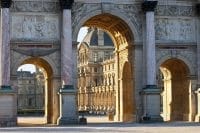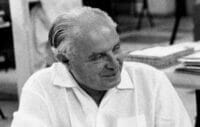
Rococo Style: How it Distincts in Architecture, Furnishings and Painting
Rococo Style: Birth and Development The Rococo, as a reflection of the trends, tastes and way of life of France…
early eighteenth century
95 x136
Workshop of Francesco Battaglioli (Modena, around 1710 – Venice, after 1796)
Baroque palace architecture with elegant staff and swans
Oil on canvas, 95 x 136 cm
Frame, 113 x 154 cm
Originally from Modena, as ancient sources indicate, Francesco Battaglioli was present in Venice, which in fact became his adoptive homeland, from 1747 to 1751, a period in which his name appears in the Fraglia dei pittori. We find him in Madrid three years later, when he was called by Ferdinand VI, for whom he painted the Views of the Royal Palaces of Aranjuez and Madrid. At the Spanish court he established a collaborative relationship with Farinelli and Metastasio, creating the sets for numerous melodramatic performances. Returning to Venice upon the death of the King of Spain in 1759, he was elected a member of the Academy in 1772: in the Venetian institution he was called to cover the chair of Perspective from 1778 to 1789. In this beautiful painting, the use of perspective is shown to be of the highest quality, capable of evoking extraordinary scenic representations, also vivid for the atmospheric and chromatic sensitivity, reaching decorative levels of notable visual impact. It can certainly be said that Battaglioli is the worthy heir of the artistic tradition inaugurated by Viviano Codazzi and continued by Giovanni Paolo Pannini and Antonio Joli, giving life to monumental results in the wake of Michele Marieschi. It was certainly no coincidence that in 1778 he inherited the chair of perspective at the Academy of Venice after the resignation of Antonio Visentini, crowning a career of undisputed success with a recognition of the highest prestige. Battaglioli's celebrated skill is well demonstrated in this canvas, where his drawing and pictorial knowledge lead to results worthy of the best vedutist tradition, without neglecting his taste for detail and narrative aspects. Equally noteworthy is the application of a dense and chromatically lively impasto, also capable of measuring the shadow lines of the architectural moldings and their depth. The great technical-executive skill of the painting and in particular the management of the shadows, bring Battaglioli's work closer to that of some of the most famous representatives of vedutist art: taking these aspects into consideration, it is not surprising that many of the works of the artist of Modena origins who worked between Venice and Spain were attributed by Pallucchini to the young Canaletto.
The subject in question is a villa with a clear Baroque taste, as highlighted by the wall decorations, the curved line, the elaborate shapes, the versatility of the volumes and the extreme sense of theatricality conferred by the statues, the balustrades, the pond and the bridge. Some birds swim inside the pond, including a pair of adult swans, a natural element inserted in a body of water bordered by statues linked to the aquatic world: a river deity inside a shell-shaped niche, a putto equipped with a trident riding a fish and several niches within which some jets of water fill shell-shaped basins. The characters that populate the scene can be clearly distinguished even though they are painted with a few rapid touches; they are distributed on multiple levels and animate the composition without taking away the role of protagonist from the architecture.

Rococo Style: Birth and Development The Rococo, as a reflection of the trends, tastes and way of life of France…

The Empire style, with its magnificent fusion of majesty and grace, remains an icon of classic furnishings, exerting a timeless charm…

Giò Ponti is one of the artists who most dominated the Italian post-war period, acting as a spokesperson for important innovations in the world…
have viewed this article in the last 30 minutes.